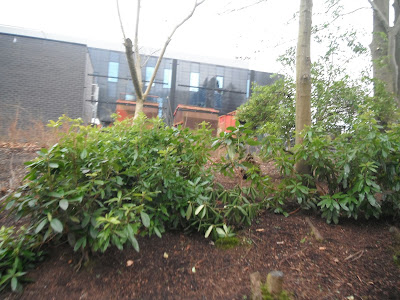Wednesday 30th April
This week's session was on Environmental Art and we had a special guest attend our workshop from Lapland who had experience in creating environmental art from snow, willow and other materials found in nature. I found it interesting to see the great sculptures and spaces that they were able to make from mould and snow using different coloured lights to illuminate certain aspects. During the Winter months especially I feel that images like the one shown on the right could stimulate the children to use their own materials to create structures of the own either outdoor or indoors depending on the materials and scale that they choose. This could also link to maths in the form of Shape, Position and Movement so would be cross-curricular.Tim Pugh and Andy Goldsworthy are the two Environmental artists that we found the easiest to research so we began by discussing what we found. Tim Pugh explains the work he does and what inspires his work on his website http://www.timpugh.co.uk/ as well as provide a photograph gallery of his work and information about workshops that he teaches for children (Pugh 2012). After discussing these artists we took a range of materials including, willow, twine, wire, hammers and knives outdoor to create our own piece of environmental art. Splitting ourselves into three groups we each took a different type of environmental art: 3D sculpture, framing which is where you create a frame to capture a view and land art where you create a piece of artwork on the ground.
I was in the land art group and we decided to use leaves as our main media then chose a lush green stretch of grass that was enclosed by a wire archway that spanned down the length of it. We saw it as an elegant pathway and this began us thinking of a journey. Once we saw the mass of brown leaves nearby we decided to use them and we all thought they looked like they would represent death, old, bad or ugly so as we waved the brown leaves up the pathway we began to incorporate green leaves and pretty flowers which were a stark contrast from the brown.
When we completed the piece we were all happy with it and time seemed to fly by once we got stuck into the creating of the piece as I know a small group of children would. However the task is time consuming so the usual hour slot that most schools and teacher provide for art would not be enough, instead an afternoon would be more realistic especially if it's the pupils first experience with Environmental Art. Out of the three areas of Environmental Art I feel that Land Art would be the best to begin with as all the resources that pupils would need could be found outdoors.
Group 1 - 3D Structure
Group 2 - Framing
Environmental Artists Gilles Bruni and Marc Babarit said that: "Man is a cosmopolitan animal who occupies the largest part of the terrestrial ecosystem. He has to share it with his fellow creatures and with a complex geophysical and living environment, which he finally dominates but only partially. Thus, we think that we have to find the ways toward a renegotiation of our relationships to the world, and...this...can be done through art" (Grande 2004 p.32), so he strongly agrees that environmental art is a great way to connect with the world around us.
Overall I enjoyed this week's session and I feel that it would be a worthwhile area of art to explore with children of all ages and stages.
References
Grande, J.K. (2004). Art Nature Dialogues: Interviews With Environmental Artists. SUNY Press.
Overall I enjoyed this week's session and I feel that it would be a worthwhile area of art to explore with children of all ages and stages.
References
Grande, J.K. (2004). Art Nature Dialogues: Interviews With Environmental Artists. SUNY Press.
Pugh, T. (2012). Tim Pugh - Environmental Artist. Available at: http://www.timpugh.co.uk/ [Accessed 1st May 2013]





















































